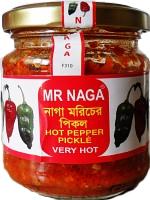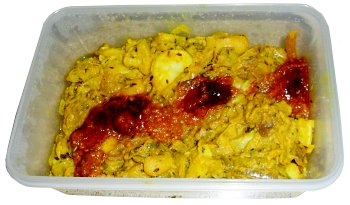This is a fairly generic recipe that should give you an idea of the sort of thing that goes in a typical sabji recipe.
Wash and clean the potatoes, removing any unsightly bits, cut in half or quarters and put in a large pan. When you have finished, put enough cold water in the pan to cover the potatoes, swirl it around and discard the water, leaving the clean potatoes.
Add enough boiling water to cover them and then another inch on top of that. Bring them to the boil and let them simmer for 20 minutes or so.
Continue with the rest of the recipe but remember that after the 20 minutes, you should turn off the heat from under the potatoes and let them continue to cook, undisturbed for may a further half hour. This will give you melt-in-the-mouth potato that hasn't fallen apart into a mush because it was being battered by bubbles of steam all of the time.
 |
Shri Naga red chillie pickle. Don't
use more than 1/2 tsp per serving. |
Whilst the potatoes cook, in the other deep saucepan, put around 2tbsp of Olive oil and the jeera. Heat until the jeera starts to brown and then add the Asafoetida and curry leaves. Warm for 30 seconds or so to let the resin dissolve. Add the Coriander powder and then the turmeric and stir it around to colour the oil.
Add the chillies and fry for 30 seconds or so and then add the chopped Lauki/Doodhi and fry for a couple of minutes.
 |
Lauki/Doodhi sabji. A diagonal stripe of
Patak's Brinjel Pickle finishes it off. |
Add the onions, ginger and garlic and fry for a further couple of minutes and then add around 50-100mls of water, bring to the boil, put on the lid and cook it until the onion is cooked.
When the potatoes are ready, drain off the water and add them to the lauki mix in the other pan and stir in gently.
Next, add the Mr Naga pickle, the Lemon Juice and the pieces of creamed coconut
Divide the Sabji between the three lunch boxes and spread out evenly so that it warms uniformly in the microwave oven at work.
Finally, add a tablespoon of Patak's Bringjal Pickle (or your favourite pickle) in a stripe along the surface of the Sabji to finish it off.